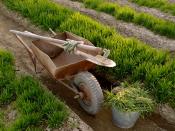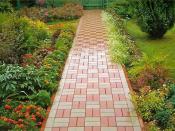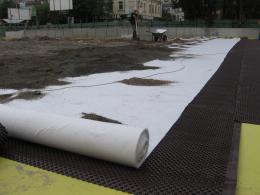Search
Login
Recommended
What is geotextile, its use in construction, the main properties of geotextile
A few years ago, construction was extremely costly in terms of finance and time. Owners of private homes were forced to depend on constant overhauls, repeated at frightening intervals. But the construction market, which is annually replenished with new products, today offers customers material in the manufacture of which innovative technologies and completely opposite processing standards are involved. Representing in its structure one of the varieties of geosynthetic materials, geotextiles, namely, this latest construction product will be discussed, it is considered a material endowed with universal characteristics.
Content
- What is geotextile? Classification of geotextile materials
- Technical characteristics of geotextiles. Density
- Geotextile Application video
- Geotextile Dornite
What is geotextile? Classification of geotextile materials
Geotextile in its structural composition is a natural or synthetic textile product with a certain level of water resistance and strength characteristics, which allows it to be used on various construction sites, mainly associated with contact with the ground and excessive humidity.

Originally designed to prevent mixing and blurring of heterogeneous layers, today geotextiles have a slightly different functional focus. Using the term geotextile, a competent specialist represents that we are talking about one of the representatives of geosynthetics, which is extremely popular in various branches of the construction industry. Inert to the action of various chemical reagents and biological factors, geotextiles are not prone to decay and are completely safe for the natural environment.
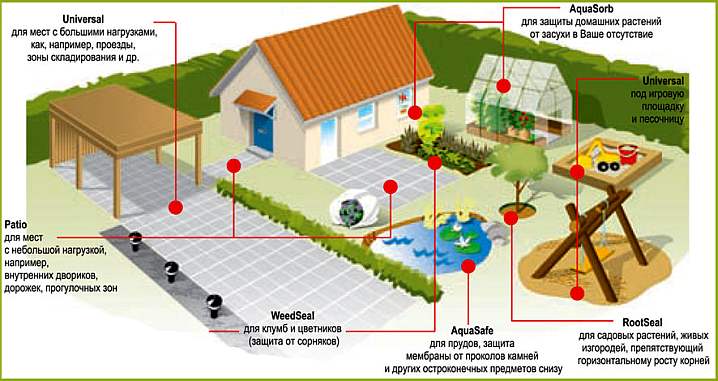
Material manufacturers such as http://dorpir.ru/, for construction they propose to classify geotextile materials according to the principle of technological features, in accordance with which they distinguish geo-fabric and geo-cloth, that is, woven and non-woven textiles, respectively.

Geotextile is a material, the technological conditions of production of which provides for the interweaving of filament fibers of various strengths, located at right angles. These features make it possible to produce a material with a high degree of deformability and water tightness, which has found its application as a reinforcing agent that helps to increase the level of strength of soil structures.
Non-woven geotextile is a fabric formed by mechanical or structural fixing of fibers.

Technical characteristics of geotextiles. Density
An important technical characteristic of geotextiles is its density. According to its indicators, it is possible to indirectly determine the load level that the material can withstand, that is, the damage threshold. The density of geotextiles, which found its application in the construction industry, ranges from 80 to 1200, and is measured in grams per square meter (g / m2). But, it is worth noting that the strength characteristics of geotextiles depend not only on its density. The manufacturing method also plays an important role in determining the degree of strength. Existing methods for manufacturing the most common geosynthetics are divided into needle-punched and thermally bonded or calendered. The strength of the latter is much lower than geotextiles made by needle-piercing, as it is more loose and thin.


Geotextile Application
Construction and road works, construction of hydraulic structures, reinforcement of soil coatings, landscape design and laying of pipelines will all do without the use of geotextiles.

hydraulic works
In an effort to prolong the durability of foundations, basements and retaining walls, builders resort to the use of geo-fabric, which acts as a separator of a layer of gravel bedding and fine-grained soil. By preventing layer mixing, geotextiles help protect concrete structures from capillary wetting with soil water. In addition, using geotextiles, it is possible to organize drainage, the effectiveness of which will be maintained at the proper level, due to the lack of contact of the concrete surface with a moisture source.

Drainage geotextiles are also used to optimally protect pipes located underground. The structural characteristics of the material allow you to create a kind of filter made of geotextiles, which will provide unhindered moisture penetration and simultaneous delay of particles of humic substances and any other finely dispersed structures. Today, the creation of effective drainage structures can not do without the use of perforated pipes, which contribute to the qualitative outflow of moisture from the foundation, the prevention of puddles on economic territories and in recreation areas. The use of geotextiles will protect pipes equipped with perforation from clogging.
installation of pipelines
The installation of a gas pipeline, the installation of sewage systems and water pipes requires the use of materials resistant to physical and mechanical influences. Geotextiles can successfully play the role of such material. Its use as a reinforcing and anti-corrosion coating will contribute to one hundred percent protection and uninterrupted operation of the pipeline and sewer system.
roofing
Speaking about the use of geotextiles, we can not forget about roofing, which is also the point of application for the use of geotextile.

A design solution for an inversion type roof provides for laying geotextiles on top of a layer of heat-insulating materials. When carrying out installation work on the arrangement of an operated roof with landscaping, geosynthetics will also help. In this case, it is laid twice: on top of the waterproofing layer, as well as between the humic composition and the layer of drainage materials, to prevent mixing of dissimilar structures.
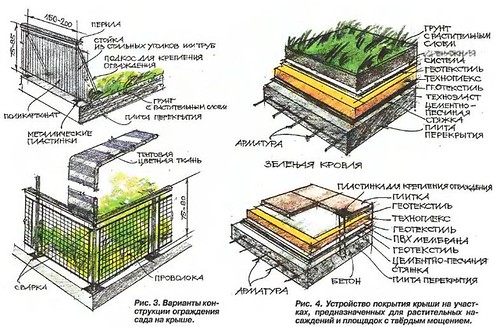
gardening geotextiles
Manufacturers of building materials also took care of gardeners and gardeners, creating a special type of geotextile used in gardening. Garden geotextile is a material with universal characteristics, the use of which ensures the protection of cultivated plants from weeds. You can forget about tiresome weeding forever if you lay out a layer of geotextile under a layer of fertile soil and create holes in it to ensure normal functioning of cultivated plants.

But this is not the only way to use geotextiles in the field of landscape design. There are certain types of geo-canvas designed to adjust the root system of large trees, which will prevent a violation of the integrity of the soil structure.
Ornamental plant cultivation also involves the use of geotextiles, but already as an improvement of the drainage system. Coarse-grained filler and soil, separated by a layer of geotextile, contribute to a better outflow of excess moisture, which contributes to the most favorable cultivation of plants.
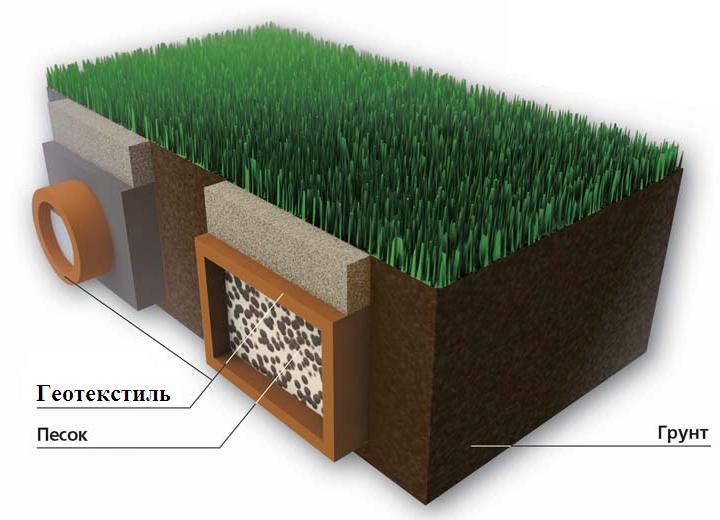
Geotextile Dornite
Geotextiles Dornite, which received its name in honor of the Institute of DorNII, is a unique geosynthetics, representing in its structure polyester material. A distinctive feature of dornite is the needle-punched manufacturing method, which provided this material with resistance to various mechanical damage and the ability to independently carry out drainage, since geotextile dornite is not a part of the drainage system, as is usually the case, but the drainage system itself.



